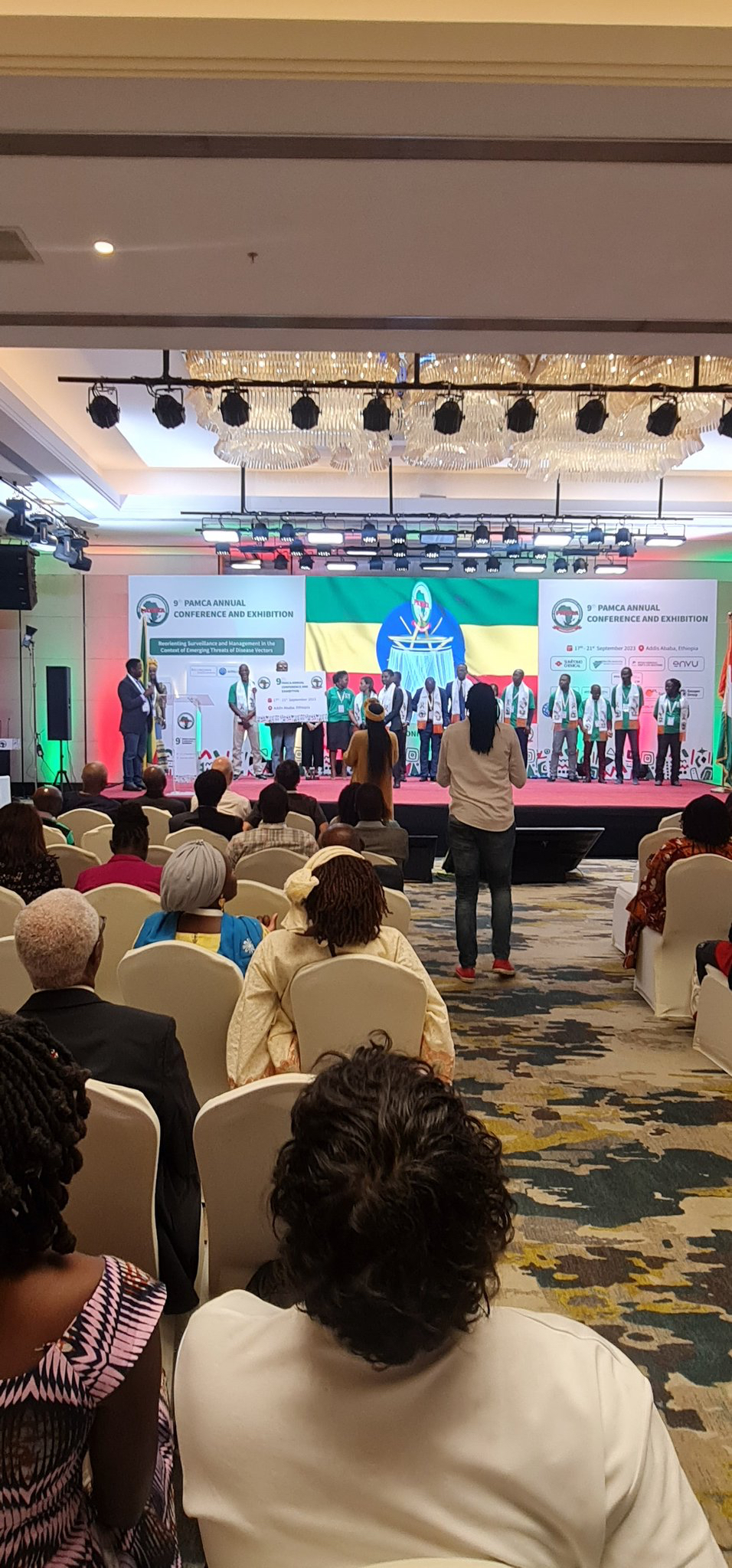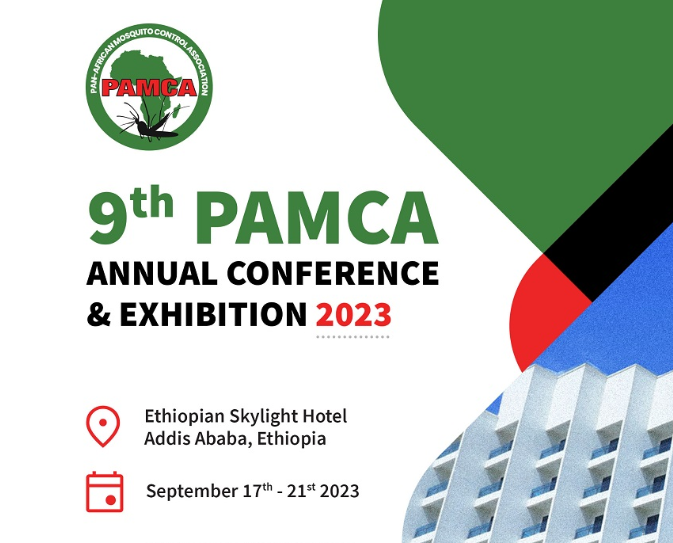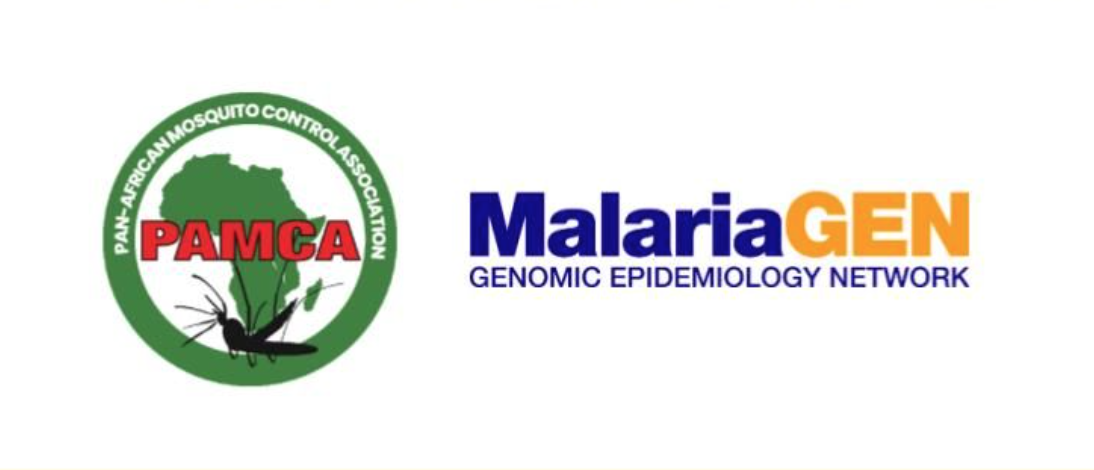9th PAMCA Annual Conference and Exhibition – 2023: Day 4
Thursday, 21st September 2023
Published: 21/09/2023
This report is brought to you by the MESA Correspondents Akua Obenewaa Danquah Yirenkyi, Ashu Fred Ayukarah, Augustino Mmbaga, Helga D.M. Saizonou, Julius Ichodo Odero, Ndey Bassin Jobe, Temesgen Ashine, and Diane Leslie Nkahe. Senior editorial support has been facilitated by Zawadi Mboma and Billy Tene.
THEMES: THEMES: Vector Control
MESA Correspondents bring cutting-edge coverage from the 9th PAMCA Annual Conference and Exhibition “Reorienting surveillance and management in the context of emerging threats of disease vectors”.
Parallel Scientific Session 17 – LLINS, IRS and insecticide resistance management
Session Chair: Camille Dossou; Co-chair: Eliningaya J Kweka
Gonse Marius Zoh (Institut Pierre Richet Vector Control Product Evaluation Centre – IPR VCPEC, Ivory Coast) presented on the need to reduce the dose application area on the Interceptor® G2 (IG2) net without compromising its efficacy. This new generation net has chlorfenapyr + alphacypermethrin as active ingredients (AI) which are effective against pyrethroid-resistant An. gambiae s.l. in Ivory Coast. The experimental hut trial in M’Bé, central Ivory Coast compared the efficacy of untreated polyester nets having “IG2 sides”’ (IG2 on the side panels only) and “IG2 roof” (IG2 on roof panel only) versus whole IG2 against insecticide resistant mosquitoes. The study established that the use of “IG2 sides” provides similar protection as the whole Interceptor® G2 (Long-Lasting Insecticidal Net) LN. They conclude that this will go a long way in saving the production cost of Interceptor® G2 LN (IG2) net and thus boost community access.
Cyrille Ndo (Centre for Research in Infectious Diseases – CRID, Cameroon) aimed to understand mosquito competence while harboring the metabolic resistant allele L119F-GSTe2. Anopheles funestus were collected from two sites in Cameroon. After forced oviposition, the eggs were reared to adult stage. To conduct experimental infection of the mosquitoes, blood of children carrying gametocytes was collected and fed to mosquitoes using artificial membrane feeding. Seven days post-feeding, their midguts were dissected, and oocysts were counted under microscopy. The rest of the body was used to genotype the resistant allele L119F-GSTe2 frequency. The study found that the number of oocysts was higher in the heterozygotes and the resistant mosquitoes, highlighting how vector competence is increased due to the resistant allele presence.
Eliningaya J. Kweka (Tanzania Plant Health and Pesticides Authority, Tanzania) presented their study on the emergence of insecticide resistance in Anopheles gambiae s.l. in Tanzania. He argued that faced with the challenge of insecticide resistance and the continued reliance on insecticides for controlling insect vectors, necessitates discovery and development of compounds such as VECTRON™ T500 with novel modes of action to complement or replace the insecticide classes approved by WHO for use in LLINS and IRS. Through experimental hut trials, they assessed the efficacy of VECTRON™ T500 at 100mg AI/m2 against laboratory and wild An. gambiae s.l. in Magugu ward, Manyara region, Tanzania. Their findings showed that VECTRON™ T500 induced mortality in both populations of An. gambiae on treated surfaces year-round. In a nutshell, strategies to preserve the susceptibility of local vectors and extend the useful life of the insecticides need to be considered before large-scale deployment.
Mouhamadou Bassir Faye (Cheikh Anta DIOP University, Senegal) characterized the resistance profile of Anopheles funestus in Nioro and Ndoffane districts of Senegal. Using WHO tube tests, he found a total resistance of the mosquitoes from both sites to the pyrethroids he used, while they were all susceptible to organophosphates and organochlorines. Further, the pre-exposition of those mosquitoes to the synergist piperonyl butoxide (PBO) showed total susceptibility recovery to the pyrethroids used, except for alpha-cypermethrin. This indicates that metabolic genes were not linked to resistance to that insecticide. Overall, his results support the use of PBO-treated nets to better achieve malaria vector control in those districts.
Tagne Djoko Simeon Carlos (Centre for Research in Infectious Diseases – CRID, Cameroon) presented on the need for genetic knowledge to identify molecular markers in An. funestus responsible for insecticide resistance. For him, this is key to the improvement of insecticide resistance. Their study assessed the role of CYP9K1 (P450) gene in conferring resistance to pyrethroid through overexpression and/or allelic variations using DNA-based diagnostic assay in samples collected across Africa in 2020 and compared with those collected in 2014. The results showed a rapid spread of 454A-CYP9K1 haplotype that negatively impacts both LLINs and novel nets. In conclusion, the study’s ability to track resistance in the field using a new DNA-based assay is key in improving resistance management strategies that rely on evidence-based decisions.
Javan Chanda (PATH, Zambia) conducted a study to monitor vector species composition and characterize insecticide resistance in three districts of Zambia. Mosquito larvae were collected and reared to adult stage. Anopheles arabiensis was the most abundant species accounting for 96% – 98% in those districts. Mosquitoes aged 2 to 5 days were exposed to pyrethroids, carbamates, organophosphates and neonicotinoids. They were susceptible to all these insecticide classes except for pyrethroids. A pre-exposition of those mosquitoes to piperonyl butoxide (PBO) before an exposure to pyrethroids showed a restored susceptibility suggesting that the resistance is driven by metabolic resistance mechanisms.
Parallel Scientific Sessions 19 – Vector bionomics: vector biology, ecology, taxonomy and population genetics & Vector surveillance, new and re-merging vectors, community-based surveillance, epidemiology, disease control programs and global health
Session Chair: Eric Ochomo; Co-chair: Jonathan Kazungu Karisa
Augustino T. Mmbaga (Ifakara Health Institute – IHI, Tanzania) presented a review on the auto-dissemination approach (ATD), which relies on the resting behavior of gravid mosquitoes to transfer lethal pyriproxyfen (PPF) to their oviposition sites, thereby inhibiting adult emergence. Augustino summarized the success of ATD with PPF in controlling malaria vectors under controlled semi-field settings. Studies to gather empirical evidence and develop biology-informed mathematical models to demonstrate the utility of this approach are underway. He highlighted that the key determining factors for the future introduction of ATD include scalable ATD devices, optimized PPF formulations, assessing community perception and acceptance, and integrating it into existing vector control interventions.
Brice Natchema Soh Fonkou (Centre for Research in Infectious Diseases – CRID, Cameroon) highlighted the association of L119F-Gste2 gene with entomological parameters of mosquito vectors. Identification of infection, blood meal, and L119F-GSTe2 genotypes were made from wild collected malaria vectors, and the result is used to compare different genotypes of L119F-GSTe2 with entomological indices. An. funestus s.s. exhibited a very high entomological inoculation rate and human blood index. An. funestus s.s. individuals with 119F/F genotypes had a significantly higher transmission intensity than their susceptible counterparts. He emphasized that An. funestus s.s. still sustains an extremely high malaria transmission and is driven by the GSTe2 metabolic resistance.
Mercy J. Tuwei (KEMRI Wellcome Trust, Kenya) spoke about the use of Matrix Assisted Laser Desorption/Ionization time-of-flight Mass Spectrometry (MALDI-TOF MS) to determine the parity status of wild malaria vectors. Age-grading aids in predicting the proportion of potentially infectious female Anopheles mosquitoes, which aids in determining the success of a control intervention. Wild mosquitoes were collected in Mozambique using CDC light traps, morphologically identified as An. gambiae and An. funestus and subjected to molecular and MALDI-TOF MS analysis. Tuwei concluded from her findings that because nulliparous and parous female mosquitoes were distinguished with 81% accuracy, further research with other wild malaria vectors must be conducted, and MALDI-TOF MS is a promising tool for routine vector surveillance.
Mgeni M. Tambwe (Ifakara Health Institute – IHI, Tanzania) spoke about a study that looked at the effect of chlorfenapyr on the development of malaria parasites inside mosquitoes, explaining that chlorfenapyr is converted to tralopyril (CL303268) to reduce ATP production. He presented data from randomized control trials in Benin and Tanzania, where the prevalence of malaria was significantly reduced when chlorfenapyr nets are used. An. gambiae resistant mosquitoes were infected a day after an 8-hour exposure in a modified WHO tunnel assay. More infections were recorded in control nets than in chlorfenapyr nets, and there were more oocytes for control exposure in terms of intensity of malaria parasites post-exposure. Chlorfenapyr, he concluded, may further reduce the occurrences of malaria in communities beyond killing mosquitoes.
Closing Ceremony
The closing ceremony of the 9th Pan-African Mosquito Control Association (PAMCA) Annual Conference and Exhibition was co-chaired by Damaris Matoke (PAMCA Programme Manager, Capacity Building, Gender Empowerment & Career Progression) and Jessy Goupeyou (PAMCA WiVC Regional Coordinator for Western Africa). They both noted that this year’s conference has been a great success, and they hope that participants were able to network with fellow scientists on the continent which could potentially lead to research collaboration. They further highlighted that the conference has also provided visibility to African scientists especially women. They concluded by thanking all sponsors of this year’s conference, especially Bill & Melinda Gates Foundation, Syngenta, and ENVU.
The closing ceremony began with an introduction of the new PAMCA board members who were warmly welcomed by the executive director and the conference participants. This board is made up of a group of prominent researchers, leaders and entrepreneurs from different countries. The outgoing board members were applauded for their enormous contribution to the association with the handing over of special gifts from the incoming board members.
Short statements were delivered by participants from different countries who expressed their appreciation to the PAMCA secretariat and the scientific committee for organizing the conference and providing such a great platform for African scientists to present their research, network, and foster collaborations.
Closing remarks
The closing remarks were delivered by Prosper Chaki (Executive Director of PAMCA), Emma Orefuwa (Ag. Executive Director of PAMCA), and Delenasaw Yewhalaw (Ethiopia Chapter Chairperson). They all expressed their gratitude and appreciation to the PAMCA – Ethiopia Chapter and the Ministry of Health of Ethiopia for hosting this year’s conference. They also thanked and applauded this year’s scientific committee as well as the PAMCA secretariat for the incredible work done in the past months to ensure this conference was a success. The sponsors of this year’s conference were also recognized, acknowledged and thanked. This was followed by a formal announcement of the 10th PAMCA conference host – Côte d’Ivoire. They highlighted that this year’s PAMCA conference was gracefully attended by a total of 810 participants and challenged the Côte d’Ivoire PAMCA chapter to increase this number to 1000 next year. This challenge was gracefully accepted by the PAMCA Côte d’Ivoire chapter.
The ceremony ended with handing over of the host flag to the PAMCA Côte d’Ivoire chapter who expressed their joy, excitement, enthusiasm and preparedness to host the 10th PAMCA Annual Conference and Exhibition in Abidjan, in 2024.

This report is brought to you by the MESA Correspondents Akua Obenewaa Danquah Yirenkyi, Ashu Fred Ayukarah, Augustino Mmbaga, Helga D.M. Saizonou, Julius Ichodo Odero, Ndey Bassin Jobe and Temesgen Ashine, with the support of a former correspondent Leslie Diane Nkahe. Senior editorial support has been facilitated by Zawadi Mboma & Billy Tene.
Published: 21/09/2023
This report is brought to you by the MESA Correspondents Akua Obenewaa Danquah Yirenkyi, Ashu Fred Ayukarah, Augustino Mmbaga, Helga D.M. Saizonou, Julius Ichodo Odero, Ndey Bassin Jobe, Temesgen Ashine, and Diane Leslie Nkahe. Senior editorial support has been facilitated by Zawadi Mboma and Billy Tene.
THEMES: Vector Control



